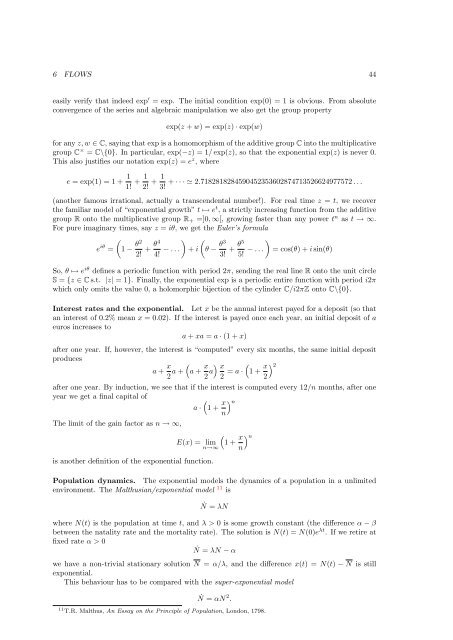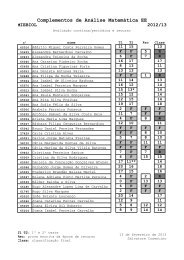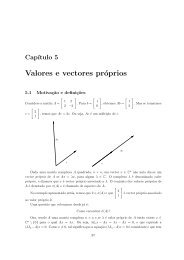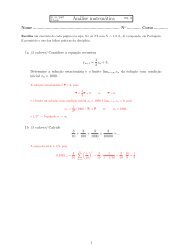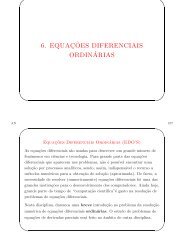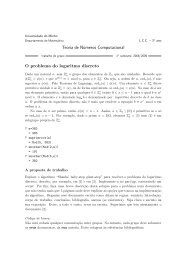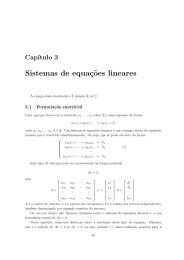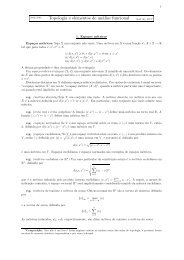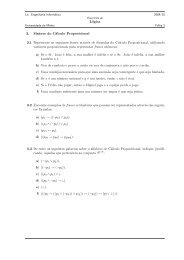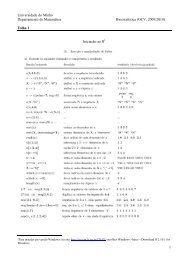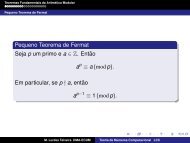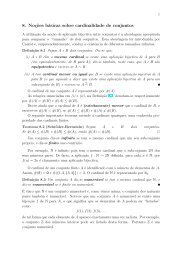My title - Departamento de Matemática da Universidade do Minho
My title - Departamento de Matemática da Universidade do Minho
My title - Departamento de Matemática da Universidade do Minho
Create successful ePaper yourself
Turn your PDF publications into a flip-book with our unique Google optimized e-Paper software.
6 FLOWS 44<br />
easily verify that in<strong>de</strong>ed exp ′ = exp. The initial condition exp(0) = 1 is obvious. From absolute<br />
convergence of the series and algebraic manipulation we also get the group property<br />
exp(z + w) = exp(z) · exp(w)<br />
for any z, w ∈ C, saying that exp is a homomorphism of the additive group C into the multiplicative<br />
group C × = C\{0}. In particular, exp(−z) = 1/ exp(z), so that the exponential exp(z) is never 0.<br />
This also justifies our notation exp(z) = e z , where<br />
e = exp(1) = 1 + 1 1! + 1 2! + 1 3! + · · · ≃ 2.7182818284590452353602874713526624977572 . . .<br />
(another famous irrational, actually a transcen<strong>de</strong>ntal number!). For real time z = t, we recover<br />
the familiar mo<strong>de</strong>l of “exponential growth” t ↦→ e t , a strictly increasing function from the additive<br />
group R onto the multiplicative group R + =]0, ∞[, growing faster than any power t n as t → ∞.<br />
For pure imaginary times, say z = iθ, we get the Euler’s formula<br />
)<br />
)<br />
e iθ =<br />
(1 − θ2<br />
2! + θ4<br />
4! − . . . + i<br />
(θ − θ3<br />
3! + θ5<br />
5! − . . . = cos(θ) + i sin(θ)<br />
So, θ ↦→ e iθ <strong>de</strong>fines a periodic function with period 2π, sending the real line R onto the unit circle<br />
S = {z ∈ C s.t. |z| = 1}. Finally, the exponential exp is a periodic entire function with period i2π<br />
which only omits the value 0, a holomorphic bijection of the cylin<strong>de</strong>r C/i2πZ onto C\{0}.<br />
Interest rates and the exponential. Let x be the annual interest payed for a <strong>de</strong>posit (so that<br />
an interest of 0.2% mean x = 0.02). If the interest is payed once each year, an initial <strong>de</strong>posit of a<br />
euros increases to<br />
a + xa = a · (1 + x)<br />
after one year. If, however, the interest is “computed” every six months, the same initial <strong>de</strong>posit<br />
produces<br />
a + x (<br />
2 a + a + x ) x<br />
(<br />
2 a 2 = a · 1 + x ) 2<br />
2<br />
after one year. By induction, we see that if the interest is computed every 12/n months, after one<br />
year we get a final capital of<br />
(<br />
a · 1 + x ) n<br />
n<br />
The limit of the gain factor as n → ∞,<br />
(<br />
E(x) = lim 1 + x ) n<br />
n→∞ n<br />
is another <strong>de</strong>finition of the exponential function.<br />
Population dynamics. The exponential mo<strong>de</strong>ls the dynamics of a population in a unlimited<br />
environment. The Malthusian/exponential mo<strong>de</strong>l 11 is<br />
Ṅ = λN<br />
where N(t) is the population at time t, and λ > 0 is some growth constant (the difference α − β<br />
between the natality rate and the mortality rate). The solution is N(t) = N(0)e λt . If we retire at<br />
fixed rate α > 0<br />
Ṅ = λN − α<br />
we have a non-trivial stationary solution N = α/λ, and the difference x(t) = N(t) − N is still<br />
exponential.<br />
This behaviour has to be compared with the super-exponential mo<strong>de</strong>l<br />
Ṅ = αN 2 .<br />
11 T.R. Malthus, An Essay on the Principle of Population, Lon<strong>do</strong>n, 1798.


